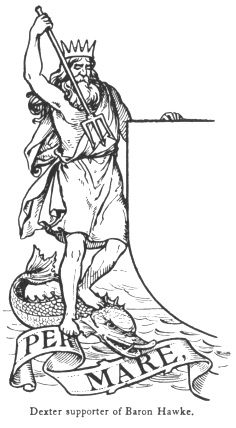
Masonic, Occult and Esoteric Online Library
Fictitious and Symbolic Creatures in Art
By John Vinycomb
Fictitious Creatures of the Sea- Poseidon or Neptune
Poseidon or Neptune, the younger brother of Zeus (Jupiter), sometimes appears in heraldry, usually as a supporter. In the ancient 
mythology he was originally a mere symbol of the watery element, he afterwards became a distinct personality; the mighty ruler of the sea who with his powerful arms upholds and circumscribes the earth, violent and impetuous like the element he represents. When he strikes the sea with his trident, the symbol of his sovereignty, the waves rise with violence, as a word or look from him suffices to allay the fiercest tempest. Poseidon (Neptune) was naturally regarded as the chief patron and tutelary deity of the seafaring Greeks. To him they addressed their prayers before entering on a voyage, and to him they brought their offerings in gratitude for their safe return from the perils of the deep.
In a famous episode of the "Faerie Queen" (Book iv. c. xi.) Spenser glowingly pictures the procession of all the water deities and their attendants:
"First came great Neptune with his three-forked mace,
That rules the seas and makes them rise and fall;
His dewy locks did drop with brine apace
Under his diadem imperial:
"And by his side his Queen with coronal,
Fair Amphitrite, most divinely fair,
Whose ivory shoulders weren covered all,
As with a robe, with her own silver hair,
And decked with pearls which the Indian seas for her prepare."
Amphitrite, his wife, one of the Nereids in ancient art, is represented as a slim and beautiful young woman, her hair falling loosely about her shoulders, and distinguished from all the other deities by the royal insignia. On ancient coins and gems she appears enthroned on the back of a mighty triton, or riding on a sea-horse, or dolphin.
Examples.—Baron Hawke bears for supporters to his shield an aggroupment of classic personations of a remarkable symbolic character, granted for the achievements of the renowned Admiral and Commander-in-Chief of the Fleet, Vice-Admiral of Great Britain, &c. &c., created Baron Hawke of Tarton, Yorks, 1776. The dexter supporter is a figure of Neptune, his mantle vert, edged argent, crowned with an eastern crown, or, his dexter arm erect and holding a trident pointing downwards in the act of striking, sable, headea silver, and resting his left foot on a dolphin proper.
Sir Isaac Heard, Somersetshire; Lancaster Herald, afterwards Garter. His arms, granted 1762, are thus blazoned in Burke's "General Armory" Argent a Neptune crowned with an eastern crown of gold, his trident sable headed or, issuing from a stormy ocean, the sinister hand grasping the head of a ship's mast appearing above the waves, as part of a wreck, all proper; on a chief azure, the Arctic pole-star of the first between two water-bougets of the second.
